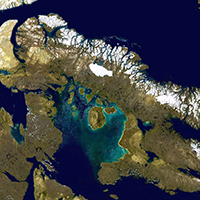Physical and chemical characteristics of 1300 lakes and ponds across the Canadian Arctic
Characteristics of Canadian Arctic lakes and ponds

Accepted: 25 August 2020
Supplementary: 107
HTML: 255
All claims expressed in this article are solely those of the authors and do not necessarily represent those of their affiliated organizations, or those of the publisher, the editors and the reviewers. Any product that may be evaluated in this article or claim that may be made by its manufacturer is not guaranteed or endorsed by the publisher.
Authors
Lakes and ponds are a major feature of the Arctic landscape and are recognized as effective ‘sentinels of change’. Here we present water chemistry characteristics of lakes and ponds (n=1300 with 26 variables) across the Canadian Arctic collated from published studies. We also extracted geological and ecoregion data in an attempt to determine the key drivers. In general, most lakes were shallow (85.4%, <10 m), nutrient (phosphorus) poor (oligotrophic = 45.6% and ultra-oligotrophic = 24.8%), located at low elevation (66.5%, <200 m asl), close to coastlines (72.5%, 0-50 km), and underlain by sedimentary geology (66.5%). The first two components from Principal Component Analysis explained 49.3% of the variation in the dataset; the first component was dominated by conductivity/carbonate materials, and the second component suggested allochthonous inputs of phosphorus. In general, bedrock geology is the primary driver of water chemistry; as such, there were major differences between lakes underlain by igneous and sedimentary rocks. Those on sedimentary bedrock tend to have higher pH, nutrients and higher inorganic ion concentrations.
Edited by
Michela Rogora, CNR-IRSA Verbania, ItalyHow to Cite
Similar Articles
- Benjamin S. GILFEDDER, Michael PETRI, Harald BIESTER, Iodine speciation and cycling in fresh waters: a case study from a humic rich headwater lake (Mummelsee) , Journal of Limnology: Vol. 68 No. 2 (2009)
- Walter AMBROSETTI, Luigi BARBANTI, Temperature, heat content, mixing and stability in Lake Orta: a pluriannual investigation , Journal of Limnology: Vol. 60 No. 1 (2001)
- Jan SYCHRA, Zdeněk ADÁMEK, The impact of sediment removal on the aquatic macroinvertebrate assemblage in a fishpond littoral zone , Journal of Limnology: Vol. 70 No. 1 (2011)
- Carla BONACINA, Renato BAUDO, Lake Orta: a case study (Part 1) , Journal of Limnology: Vol. 60 No. 1 (2001)
- Svein Birger WÆRVÅGEN, Jens Petter NILSSEN, Seasonal dynamics and life histories of pelagic cladocerans (Crustacea; Cladocera) in an acid boreal lake , Journal of Limnology: Vol. 70 No. 1 (2011)
- Thomas C. Jensen, Winter decrease of zooplankton abundance and biomass in subalpine oligotrophic Lake Atnsjøen (SE Norway) , Journal of Limnology: Vol. 78 No. 3 (2019)
- Ana Maria GERALDES, Maria-José BOAVIDA, Do distinct water chemistry, reservoir age and disturbance make any difference on phosphatase activity? , Journal of Limnology: Vol. 62 No. 2 (2003)
- Liisa NEVALAINEN, Tomi P. LUOTO, Temperature sensitivity of gamogenesis in littoral cladocerans and its ecological implications , Journal of Limnology: Vol. 69 No. 1 (2010)
- Pedro M. SÁNCHEZ-CASTILLO, Eduardo J. LINARES-CUESTA, D. FERNÁNDEZ-MORENO, Changes in epilithic diatom assemblages in a Mediterranean high mountain lake (Laguna de La Caldera, Sierra Nevada, Spain) after a period of drought , Journal of Limnology: Vol. 67 No. 1 (2008)
- Andrea Gall, Martin J. Kanz, Serena Rasconi, Erratum - Daphnia magna fitness during low food supply under different water temperature and brownification scenarios , Journal of Limnology: Vol. 77 No. 2 (2018)
<< < 66 67 68 69 70 71 72 73 74 75 > >>
You may also start an advanced similarity search for this article.
-
Jonathan B. Martin, Andrea J. Pain, Ellen E. Martin
-
Zhizhong Li, Madjid Hadioui, Kevin J. WilkinsonNanomaterials : 2023

 https://doi.org/10.4081/jlimnol.2020.1973
https://doi.org/10.4081/jlimnol.2020.1973





